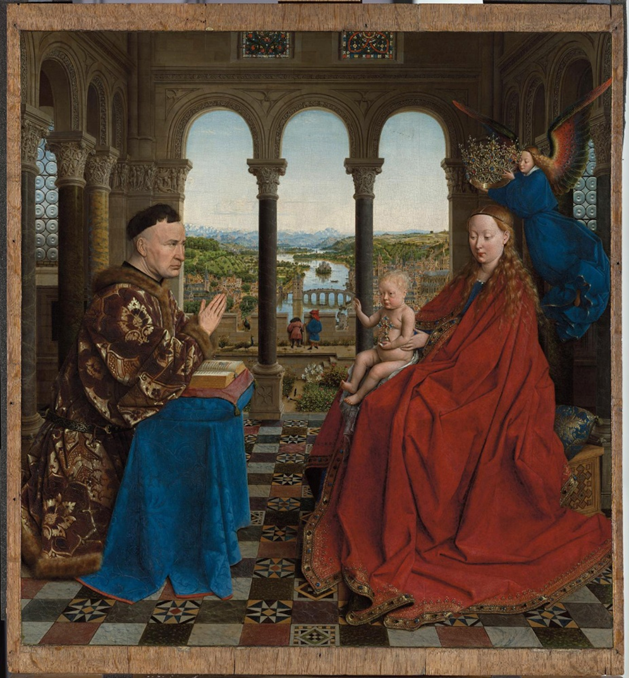The Northern Renaissance
The Madonna of Chancellor Rolin by Jan van
Eyck c. 1435
Biography
Jan van Eyck (before 1390 – July 9, 1441) was known as the inventor of oil painting. He used oil paint to create highly detailed
paintings. One of his most famous works
is titled The Madonna of Chancellor Rolin painted in 1435 in the Netherlands. This painting is considered one of the most important
works of the Northern Renaissance because of the mastery of detail, realism and
use of light. Today there are 20
surviving van Eyck paintings dated between 1432 and 1439.
The Painting
Nicolas Rolin Chancellor
of the Duchy of Burgundy commissioned Jan van Eyck in 1435 to paint this masterpiece. The painting hung in the Saint Sebastian Chapel
in the Notre-Dame-du-Chastel in Autun, where it remained until the church burnt
down. In
1805, the painting was moved to the Louvre where it remains today.
The Louvre, in 2024, created a special
exhibit centered around The Madonna of Chancellor Rolin that celebrated the
historic conservation work that was performed on the painting. Layers of oxidized varnish that darkened the
paint were stripped restoring the painting.
The image located on the Louvre’s website shows the painting's incredible detail.
The
picture has so much detail that the viewer has to closely look at each section
to better understand the art elements. The
first thing that I see is the deep red cape.
Jan van Eyck’s use of color and tone created a realistic looking article of clothing
that drapes over Mary. The floor, arches,
and countryside in the background create depth in the painting. Jan van Eyck's use of light to create the sky also
added to the depth of the painting. He
did this through a technique called atmospheric perspective. Humanism
Jan van Eyck’s art work included symbolism, detailed images, and lighting. These features are considered factors in the
renaissance humanism in Northern Europe. The oil paint that he used allowed him to
create texture and subtle color transitions which enhanced his ability to more
deeply express himself as an artist while he was able to capture the true image
of his subjects. Oil painting allowed him to reach his full potential
as an artist which was central to humanism.
Personal Thoughts
I like van Eyck’s work. I am intrigued by the incredible level of
detail van Eyck used to create such realistic images. The symbolism that he incorporated into the painting is also something to consider.
Not only did van Eyck create a beautiful painting, he included objects
in the painting that had meaning. This class, although we have
just started the semester, has already taught me how to better appreciate
art. I am going to have a different
perspective when I look art in the future.
Citations
Madonna of chancellor Rolin (2024) Wikipedia. Available at: https://en.wikipedia.org/wiki/Madonna_of_Chancellor_Rolin#:~:text=It%20was%20commissioned%20by%20Nicolas,church%20burnt%20down%20in%201793 (Accessed: 16 February 2025).
A new look at Jan van Eyck (no date) Le Louvre. Available at: https://www.louvre.fr/en/exhibitions-and-events/exhibitions/a-new-look-at-jan-van-eyck#selected-works (Accessed: 16 February 2025).
Artble (2017) Madonna and chancellor Rolin, Artble. Available at: https://www.artble.com/artists/jan_van_eyck/paintings/madonna_and_chancellor_rolin#:~:text=The%20painting%20is%20arranged%20in%20a%20symmetrical%20composition,a%20deep%20red%20color%20and%20brocaded%20with%20jewels. (Accessed: 16 February 2025).
Renaissance humanism (no date) Students of History Teaching Resources. Available at: https://www.studentsofhistory.com/renaissance-humanism#:~:text=Jan%20Van%20Eyck%27s%20work%20depicts,and%20detailed%20textures%20and%20lighting. (Accessed: 16 February 2025).
A discussion of Madonna of chancellor Rolin by Van Eyck (no date) TripImprover. Available at: https://www.tripimprover.com/blog/madonna-of-chancellor-rolin-by-jan-van-eyck (Accessed: 16 February 2025).


It is impossible to talk about the Northern Renaissance without saying Jan van Eyck’s name, he is one of the most influential artists of his time. One of my favorite things about his work is his use of fine detail in every aspect. You could spend hours looking at one of his paintings and still discover something new. I honestly cannot pick my favorite visual in this painting. The influence of humanism, royalty, and the Catholic religion is, no doubt, seen in this work. Van Eyck captures the intricacies of religion and the world through his depictions of life, both secular and religious, and the symbolism within his paintings. Interestingly, the design of the arches and columns in this painting is a blend of Romanesque and Gothic architecture. The arches resemble those of the Romanesque styles due to their round nature and simple design. Meanwhile, the columns resemble a Gothic style, complete with the complex design of the capitals. These architectural styles would be something that van Eyck would have seen every day.
ReplyDelete